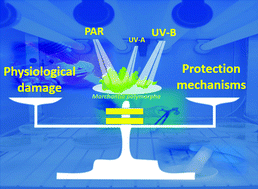Isn't it always the way? This thread was dead for a while there and now it has sprung to life again. Some of the things I wanted to address have already been addressed, but I'll go over them again briefly.Like I mentionned, I never heard anyone talk about Emerson effect before you so that's kinda funny as you explained it like someone who just discovered it. Far red is photosynthetic and it is part of the photosynthesis. UV is not. actually uv is totally useless except for UVB and the only reliable UVB light are T5 , thats why I said commercials are not ready for it. Now the hype is on far red but thing is you better spend on more effective photons! Why? Because far red cause morphologic change in plant and it doesnt benefit production in cannabis as it would with leafy greens. Leggy and stretchy plant are not desirable in my book.And UV damages plants thats just unproductive.

Photosynthetically-active radiation, UV-A and UV-B, causes both common and specific damage and photoprotective responses in the model liverwort Marchantia polymorpha subsp. ruderalis
We studied the effects of different radiation treatments on the physiology and UV-absorbing compounds of the model liverwort Marchantia polymorpha subsp. ruderalis. Starting from gemmae, samples were exposed to five radiation treatments: low photosynthetically active radiation (PAR), low PAR+...pubs.rsc.org
Wrong. it does have far red but no UV. And wrong again if you had read , they suffered from drought I forgot one irrigation. Theres is no way my feed lack of nitrogen.
View attachment 18963185
View attachment 18963192
@Rocket Soul mentioned this, and it was the first thing I picked up on. @weedemart, you should have picked up on this, too, because it was a very obvious mistake.
This is WRONG. The scale is out by over 50nm. I can see why someone might think that Far Red is photosynthetic after looking at this pigment absorption graph, but like so many things the dodgy Chinese LED makers publish, it's just bullshit.
This is what the pigment chart should look like. There is a caveat (there always is) and that is you will see a lot of variation in these graphs as to where, exactly, each peak is, but they are mostly in the ballpark. Some of the discrepancy comes from which solvents they use to dissolve the chlorophyll and other pigments to measure absorption. There are a few papers out there arguing that chlorophyll absorption is much bluer (the peaks are further to the left, into the shorter wavelengths) than most absorption graphs show. I'll save that for a different debate.
I chose this graph because it shows Pr and Pfr in relation to Chl A and B, as well as anthocyanins. Note peak absorption of Pfr – this is why the Emerson and other effects peak at around 720-730nm and then drop off. Note that Pfr also goes into the UV zone – most graphs don't show this.
But also of interest is the Pr line that goes into the near-UV zone – notably around 400nm. There is a lot going on at these wavelengths that are not typically covered by horticultural LEDs.
The Emerson Effect initially brought to light (pun intended) the possibility of there being two light-reactive centres, or photosystems, and indeed this was the case. At the time of Emerson's research, there was thought to be only one – Photosystem 1. That's why PS2 comes before PS1 – because PS1 was discovered first, even though it is second in line in the reaction centres.
I will revise what I said about Far Red light not being photosynthesised, because a very small amount of it is, but this is a quirk of ascribing 700nm to PS1 as the actual wavelengths it absorbs extend a small way beyond 700nm. But my earlier assertion that the electron chain only goes in one direction is still true: at some point just beyond 700nm, individual photons do not carry enough energy to excite an electron to a high enough state to photosynthesise.
The Emerson Effect, however, is due to the quenching effect of Far Red light that lowers the temperature of the reaction centres (notably PS1) which allows greater absorption of longer wavelengths in the red part of the spectrum. It is now believed the Emerson effect also increases absorption of shorter wavelengths in the blue region.
So, Far Red is photosynthesised but only to a very minor extent. Far Red increases the quantum yield of photosynthesis by lowering the temperature of the reaction centres.
That is the Emerson Effect.
As for the Spider Farmer spectrum itself, there is no way they use 760nm diodes. And if they did. they would be fucking idiots because 760nm diodes are much less efficient than 725-730nm diodes, and at 760nm nearly all the benefits of Far Red are gone – because hardly any of it is absorbed.
Also, where's the 760nm peak in the graph? There isn't even a 720m peak. The graph does show a slightly longer Far Red tail than typical LEDs indicative of the addition of a VERY small number of 730nm diodes, but this light has only around 2-3% Far Red.
How do I know? Does this graph look familiar? This is a Mars Hydro (same company as Spider Farmer) we tested on an $80,000 goniometer. Yes, I have access to a goniometer so can test these things for real. OK, credit where it's due: LED Teknik does the testing for us. They are our strategic partner in LED fixture design.
BTW, that's the true efficiency there: 2.57 umol/j – so don't listen to any bullshit Chinese claims about "2.9 umol/j" or whatever.
So the main reason your plants weren't stretching is due to there being very little Far Red and over 20% blue.


